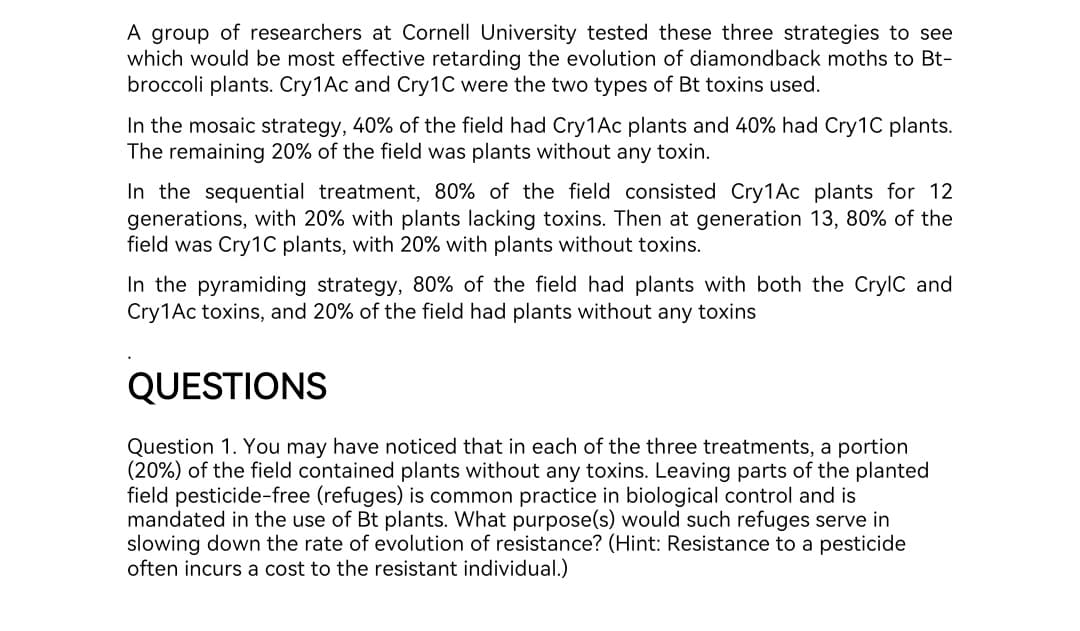Question 1. You may have noticed that in each of the three treatments, a portion (20%) of the field contained plants without any toxins. Leaving parts of the planted field pesticide-free (refuges) is common practice in biological control and is mandated in the use of Bt plants. What purpose(s) would such refuges serve in slowing down the rate of evolution of resistance? (Hint: Resistance to a pesticide often incurs a cost to the resistant individual.)
Question 1. You may have noticed that in each of the three treatments, a portion (20%) of the field contained plants without any toxins. Leaving parts of the planted field pesticide-free (refuges) is common practice in biological control and is mandated in the use of Bt plants. What purpose(s) would such refuges serve in slowing down the rate of evolution of resistance? (Hint: Resistance to a pesticide often incurs a cost to the resistant individual.)
Human Anatomy & Physiology (11th Edition)
11th Edition
ISBN:9780134580999
Author:Elaine N. Marieb, Katja N. Hoehn
Publisher:Elaine N. Marieb, Katja N. Hoehn
Chapter1: The Human Body: An Orientation
Section: Chapter Questions
Problem 1RQ: The correct sequence of levels forming the structural hierarchy is A. (a) organ, organ system,...
Related questions
Question

Transcribed Image Text:A group of researchers at Cornell University tested these three strategies to see
which would be most effective retarding the evolution of diamondback moths to Bt-
broccoli plants. Cry1Ac and Cry1C were the two types of Bt toxins used.
In the mosaic strategy, 40% of the field had Cry1 Ac plants and 40% had Cry1C plants.
The remaining 20% of the field was plants without any toxin.
In the sequential treatment, 80% of the field consisted Cry1Ac plants for 12
generations, with 20% with plants lacking toxins. Then at generation 13, 80% of the
field was Cry1C plants, with 20% with plants without toxins.
In the pyramiding strategy, 80% of the field had plants with both the CrylC and
Cry1Ac toxins, and 20% of the field had plants without any toxins
QUESTIONS
Question 1. You may have noticed that in each of the three treatments, a portion
(20%) of the field contained plants without any toxins. Leaving parts of the planted
field pesticide-free (refuges) is common practice in biological control and is
mandated in the use of Bt plants. What purpose(s) would such refuges serve in
slowing down the rate of evolution of resistance? (Hint: Resistance to a pesticide
often incurs a cost to the resistant individual.)
Expert Solution
This question has been solved!
Explore an expertly crafted, step-by-step solution for a thorough understanding of key concepts.
This is a popular solution!
Trending now
This is a popular solution!
Step by step
Solved in 2 steps

Knowledge Booster
Learn more about
Need a deep-dive on the concept behind this application? Look no further. Learn more about this topic, biology and related others by exploring similar questions and additional content below.Recommended textbooks for you

Human Anatomy & Physiology (11th Edition)
Biology
ISBN:
9780134580999
Author:
Elaine N. Marieb, Katja N. Hoehn
Publisher:
PEARSON

Biology 2e
Biology
ISBN:
9781947172517
Author:
Matthew Douglas, Jung Choi, Mary Ann Clark
Publisher:
OpenStax

Anatomy & Physiology
Biology
ISBN:
9781259398629
Author:
McKinley, Michael P., O'loughlin, Valerie Dean, Bidle, Theresa Stouter
Publisher:
Mcgraw Hill Education,

Human Anatomy & Physiology (11th Edition)
Biology
ISBN:
9780134580999
Author:
Elaine N. Marieb, Katja N. Hoehn
Publisher:
PEARSON

Biology 2e
Biology
ISBN:
9781947172517
Author:
Matthew Douglas, Jung Choi, Mary Ann Clark
Publisher:
OpenStax

Anatomy & Physiology
Biology
ISBN:
9781259398629
Author:
McKinley, Michael P., O'loughlin, Valerie Dean, Bidle, Theresa Stouter
Publisher:
Mcgraw Hill Education,

Molecular Biology of the Cell (Sixth Edition)
Biology
ISBN:
9780815344322
Author:
Bruce Alberts, Alexander D. Johnson, Julian Lewis, David Morgan, Martin Raff, Keith Roberts, Peter Walter
Publisher:
W. W. Norton & Company

Laboratory Manual For Human Anatomy & Physiology
Biology
ISBN:
9781260159363
Author:
Martin, Terry R., Prentice-craver, Cynthia
Publisher:
McGraw-Hill Publishing Co.

Inquiry Into Life (16th Edition)
Biology
ISBN:
9781260231700
Author:
Sylvia S. Mader, Michael Windelspecht
Publisher:
McGraw Hill Education